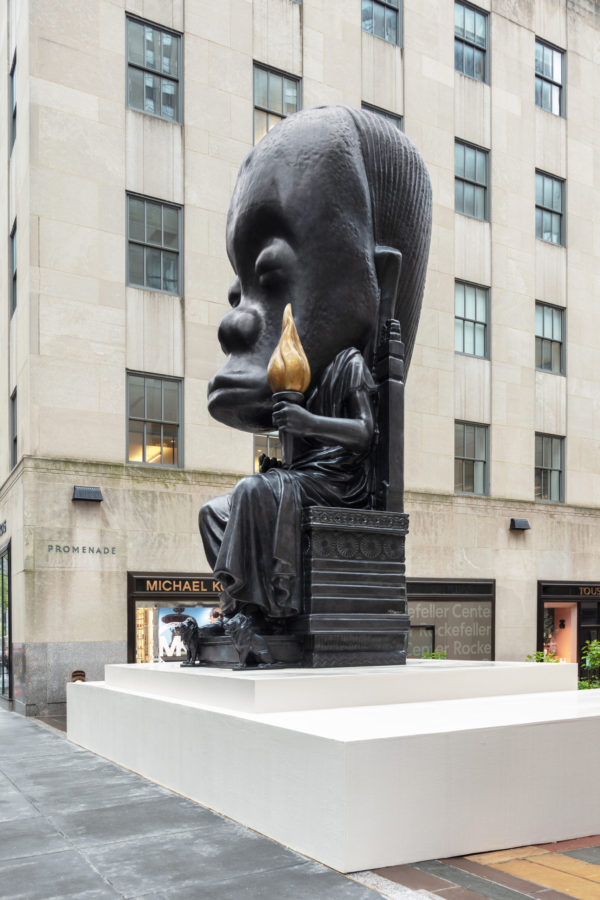Sanford Biggers "Oracle" to Mark Hammer Transformation
 |
| Sanford Biggers, Oracle, 2021, as installed at Rockefeller Center, New York. Photo by Daniel Greer, courtesy of Art Production Fund |
UCLA's Hammer Museum has released further details about its Michael Maltzan-designed expansion, now set to open March 26, 2023. Sanford Biggers' Oracle will initially occupy a new sculpture terrace at Wilshire Blvd. and Glendon Ave. This is the 25-ft-tall bronze sculpture that was displayed at Rockefeller Center in 2021. It's part of a series that recombines African and European sculptural traditions.
UCLA has a sculpture garden, but it's a hike from the Hammer and not nearly so of the moment as the Hammer's usual offerings. Coincidentally, a Biggers sculpture was also chosen to mark the debut of the Orange County Museum of Art's new building.
The Hammer's new lobby will open with a new, large-scale work by Chiaru Shiota. A glass-enclosed street-level gallery will hold Rita McBride's laser installation Particulates (2021).
The Hammer's transformed space is named for pomegranate-and-pistachio magnates Lynda and Stewart Resnick and—whew!—will retain the museum's free admission policy.
 |
| Rendering of entrance at Wilshire and Westwood, courtesy of Michael Maltzan Architecture. The sculpture terrace is not visible in this image |
Comments
What "politics"?
"Acceptable" to whom?
Notions of acceptable/not acceptable in art could be a good thing.
Ditto the notion of politically correct/not correct.
All is fair in love and war and the marketplace of artistic ideas, I find.
À chacun son goût (to each his own).
THE BEST OF SCULPTORS, THE WORST OF SCULPTORS
November 30, 1993. On the same day that the artist Rachel Whiteread became the first woman to receive the prestigious Turner Prize for "House," her controversial concrete cast of the interior of a three-story building, she also accepted the K Foundation award for Britain's worst artist, The Times reported.
"House" started a furor and debate over contemporary art, and at first, Ms. Whiteread wanted to reject the K Foundation's award, which was bestowed by a group "known for its irreverent antics," according to the article. But she changed her mind when she was told that the $60,000 cash prize would be burned if she did not accept it. Ms. Whiteread announced she would donate some of the money to a homeless charity and give the rest in grants to young artists.
[For more on the subject "House," see the following article... https://www.widewalls.ch/magazine/rachel-whiteread-house ]
> THE WORST OF SCULPTORS
Per my previous comment about how everything and everyone are increasingly becoming a series of ironies, contradictions and cognitive dissonance---as filtered through a social, political lens.
"Beauty (and culture-politics) are altogether in the eye of the beholder."
The problem at the moment is that there are people with a lot of money who follow only one rule: If one pays a lot of money for the object, it must be good.
Even though it's obvious you don't have that kind of money, you have a lot in common with those pseudo-collectors. The pseudo-collectors think they know what is really happening because like you they have come to the conclusion that "beauty' can be anything in the face of all the irony, contradiction, and cognitive dissonance.
But the true collectors were never looking for "beauty" in the first place. And, in any case, the true collectors long ago concluded that if there is such a thing as beauty, in its present incarnation it would emerge beyond irony and contradiction.
--- J. Garcin
> be anything in the face of all the irony,
> contradiction, and cognitive dissonance.
I was actually pointing out the ironies, contradictions, double standards and hypocrisies of that particular mindset.